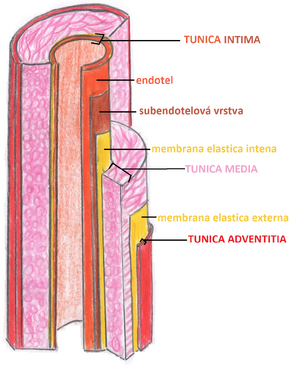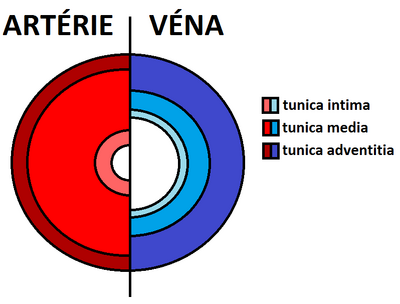Circulatory system
Reason for creation
The circulatory system has evolved to allow a good supply of nutrients and oxygen to the tissues. This could no longer be provided by diffusion, which is significantly inefficient (slow) over long distances. In animals with small body size, however, diffusion amply replaces the circulatory system.
Systems
There are two basic types of circulation systems.
- Open system - this is a system in which blood is pumped into haemocoels (open blood spaces).
- Closed system - is the one we have, for example. The blood is pumped in it in a closed circuit, in which the blood circulates.
Pumps
For the proper functioning of both open and closed systems, the presence of a pump is required to drive the blood. There are two types of pumps.
- Peristaltic pump - works like peristalsis of the intestines. The blood is driven by smooth muscle, in which there is a gradual circular contraction.
- Chamber pump - works by means of valves that open only when pressure is applied from the correct side. They will not open the other way round. The contraction occurs either by its own contractile wall (i.e. the pump wall is made of muscle) or by pressure from surrounding tissues (most commonly skeletal (i.e. striated) muscle contraction).
The human circulatory system contains a chamber-type pump with its own contractile wall, and even one that consists of four subunits (two main pumps (chambers) and two auxiliary pumps (atria)). But that is not all. Our circulation system also includes a second type of pump - the peristaltic pump. This type is found in the large veins of the lower limbs. It is called the muscular pump. This pump works against the force of gravity (if the person being observed is standing) and downstream of the direction of blood flow. It is helped by the valves.
Types of circulation
There are again two basic types of circulation:
- Simple circulation - there is only one circulation, in which both the pump and the place for oxygenation of the blood are arranged in a row. Thus, there is no pulmonary and body circulation as in the other type of circulation.
- Double circulation - double is called because it contains two circulations - one pulmonary and one corporal. The two are also arranged in series (i.e. they are connected in series), but both have their own pump. However, the two have different pressures, which is why the pulmonary circulation is called low pressure and the corporal circulation is called high pressure.
Heart
Ventricle wall thickness
- right ventricle: 3-4 mm;
- left ventricle: 16-20 mm;
Koch's triangle
- bounded by the base of the septal tip of the tricuspid valve, the sinus coronarius orifice into the right atrium, and a lash extending from the v. cava inferior orifice into the right ventricle to the septum (in the depth of this lash is Todaro's tendon attaching to the trig. fibrosum dextrum); subendocardially, the nodus atrioventricularis is located in Koch's triangle.
Valsalva's sinuses
- sinus aortae (dexter, sinister, posterior) - extension of the ascending aorta above the individual valvulae of the aortic valve, the right and left coronary arteries branch off from the right and left sinus of Valsvalva.
Pressure parameters
- central venous pressure: 0-8 mmHg;
- wedge pressure: 4-14 mmHg;
- pressure in the right atrium: 0-8 mmHg;
- pressure in the right ventricle: systolic 25-30 mmHg (enddiastolic 0-8 mmHg);
- pressure in the truncus pulmonalis: 25-30 mmHg;
- pressure in the left atrium: 4-12 mmHg;
- pressure in the left ventricle: systolic 100-140 mmHg (enddiastolic 4-12 mmHg);
- pressure in the aorta: 100-140 mmHg;
Other hemodynamic parameters
- CO: 4–8 l/min;
- CI: 2.5-4.2 l/min/m2 (CO/body surface);
- ejection fraction: 60-75%;
Blood vessels
Blood vessels are part of the lymphatic and cardiovascular systems. Through the cardiovascular system, oxygen and nutrients are distributed in the body to the tissues and waste products of metabolism to the excretory organs. Furthermore, the transport of hormones to the target organs is mediated. Using the lymphatic vascular system, fluid from the intercellular spaces returns to the blood circulation. These systems thus contribute to the integration of the function of the entire organism.
Vessels are divided into blood vessels and lympatic vessels.
In blood vessels, we further distinguish arteries, veins and capillaries.
General structure of blood vessels
Blood vessels are composed of three basic structures: tunica intima, tunica media and tunica adventitia.
Tunica intima
It consists of a layer of endothelial cells abutting the basal lamina and a subendothelial layer.
Endothelial cells
- Polygonal, flat;
- stretched in the direction of blood flow;
- the central region arches into the lumen of the vessel;
- they have thin lateral projections - they often contain pinocytic vesicles (for the transport of substances).
Lamina basalis
- Endothelial cell product;
- may or may not be continuous.
Subendothelial layer
- Thin callagenous tissue;
- may contain smooth muscle cells;
- may contain smooth muscle cells;
Tunica media
This layer is formed by smooth muscle cells, that produce intercellular mass (glycosaminoglycans, chondroitin sulfate and proteoglycans). We also find reticular fibers and elastic fibers here. At the edges, they can condense in the membrana elastica interna et externa (they separate the tunica media from the tunica externa and tunica intima).
Tunica adventitia
The layer is made up of collagen fibers, in which longitudinal collagen (primarily collagen I ) and elastic fibers predominate. We also find fibroblasts, adipocytes and smooth muscle cells in larger vessels.
Nutrition of blood vessels
Nutrition of blood vessels
The nutrition of the wall of small vessels is provided by the diffusion of nutrients and oxygen from the blood flowing inside the given vessel. Vessels that are larger than 1 mm in diameter have their own vascular system developed in the walls. This system is called the vasa vasorum. Vasa vasorum arise as branches of one's own artery or a neighboring artery. These vessels branch in the tunica adventitia and in the outer regions of tunica media. Because there is less oxygen concentration in venous bloode vasa vasorum occur more often in the walls of veins than in the walls of arteries.
Lymphatic drainage
Lymphatic capillaries are found mainly in the tunica adventitia of vessels. In the veins, they penetrate deeper (up to the tunica media).
Vasomotor innervation
A network of vasomotor nerve fibers (sympathetic unmyelinated) is found in the walls of most blood vessels, which contain smooth muscle cells. Their chemical mediator is noradrenaline, which when released causes vasoconstriction. In arteries, nerve fibers usually do not penetrate the tunica media, noradrenaline has to diffuse several micrometers to reach the smooth muscle cells of the tunica media. In veins, we find nerve endings in the tunica adventitia and in the tunica media, but the total number of nerve endings is smaller than in arteries.
Links
Related articles
Source
- PASTOR, Jan. Langenbeck's medical web page [online]. [cit. Srdce (poznámky), 2009]. <https://langenbeck.webs.com/>.
Used literature
- TROJAN, Stanislav, et al. Lékařská fyziologie. 4., přepracované a upravené edition. Grada, 2003. 772 pp. ISBN 80-247-0512-5.


